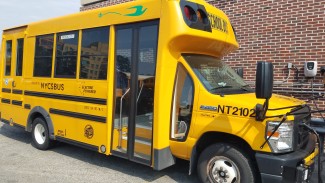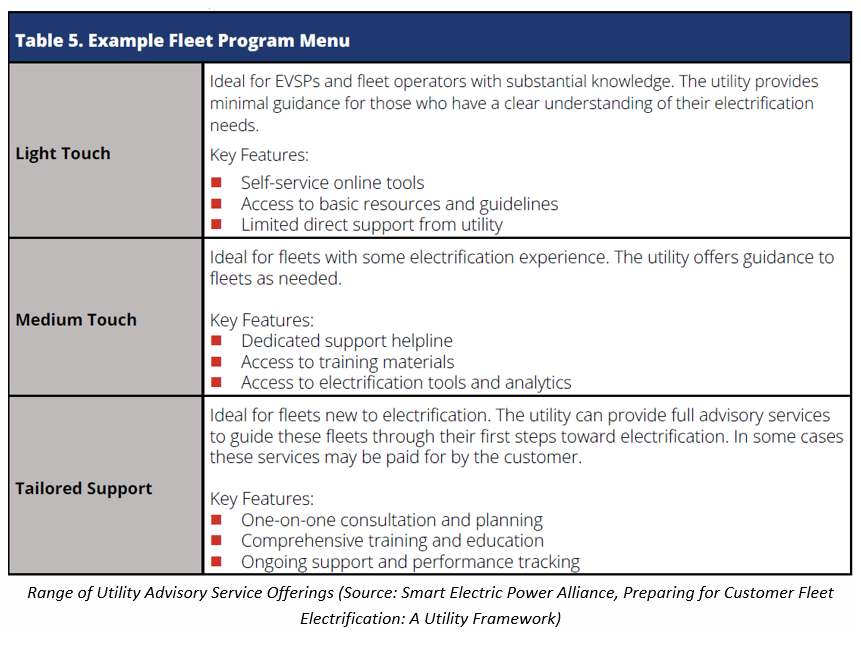Fleet vehicles that burn gasoline or diesel such as trucks cause a disproportionate share of U.S. transportation emissions. Proactive engagement from utilities can help fleet operators navigate the transition to electric vehicles, cutting operating costs and pollution.
Major companies such as Walmart are leading the way with electric fleets, having already deployed hundreds of electric vehicles. However, over 90% of vehicle fleets in the United States consist of fewer than 100 vehicles, and mid-size fleet operators often lack the know-how and resources of the largest companies to transition to EVs. Utilities are uniquely positioned to help more fleet operators, especially those with smaller fleets, begin to move to EVs.
Over the last few years, utilities have been running fleet electrification programs and taking innovative approaches to engage and onboard fleet customers. For example, Michigan utility DTE Energy has created a seven-step process to guide how it connects with fleet managers, and Con Edison in New York supports fleets with incentive programs and technical assistance. This blog post explores how utilities can engage fleet operators.
Four steps for utilities to connect with fleet operators about electrification
The following steps, informed mainly by a Smart Electric Power Alliance’s (SEPA) case study for DTE and its Utility Fleet Electrification Framework, outline how utilities can connect with fleet operators and help them shift to EVs:
- Analyze data: Utilities can purchase and analyze data on operational patterns, fuel consumption, mileage, and other relevant factors for local fleets to identify potential electrification candidates in their service territories. Information can be obtained from third-party data providers, informed partners such as the local Clean Cities Coalition, or by tracking EV grant awards in the utility’s service territory.
- Proactively engage: Utilities should proactively pursue engagement with fleet managers before they may have even begun considering electrification, helping familiarize the fleet managers with baseline knowledge of electric fleets, while also allowing utilities to address concerns early on and share real-world examples.
- Provide technical support: Utilities can assist fleet operators with technical and financial assessments such as total cost of ownership calculations, assessing charging infrastructure requirements, upfront costs, and grid impacts. This helps fleet operators learn about the costs and infrastructure considerations of electrifying fleets directly from experts.
- Tailor the level of engagement: Utilities can tailor the level of support they offer based on the fleet operator’s familiarity with electrification. Detailed in SEPA’s Utility Customer Fleet Electrification Framework table below, this can range from light-touch support to full advisory services.
Fleets derive value from proactive utility outreach
Fleet operators, such as NYC School Bus Umbrella Services (NYCSBUS), a non-profit that manages and operates school buses in New York City, have experienced the benefits of proactive utility engagement in fleet electrification. Con Edison (ConEd) helped NYCSBUS—which now operates 27 electric school buses—from the very beginning of the bus electrification process.
Upon being awarded a grant under the EPA’s Clean School Bus Program, ConEd reached out to NYCSBUS to coordinate and guide the activation of their electric school buses. With only a small portion of NYCSBUS’s 800 routes served by electric buses, the team appreciated ConEd’s early involvement and outreach since they were unfamiliar with the technology.
ConEd’s wide range of fleet support services has been valuable in helping NYCSBUS navigate the technical aspects of transitioning to an electric school bus fleet. When NYCSBUS struggled to get enough power for their buses, the utility helped NYCSBUS overcome the challenge by allowing them to use load management to use the existing electric capacity on their service. ConEd has also helped NYCSBUS walk through all the steps needed to start electrifying the fleet and fill out applications for the utility’s SmartCharge Commercial and make-ready incentive programs to maximize financial savings.
“ConEd has been really great about assigning a team and working through the new processes. We've had major decisions and also a lot of one-off queries, and they have helped us not be alone in this decision-making and implementation,” says Matt Berlin, NYCSBUS CEO.
Advisory support bolstered by incentives brings more electric fleets online
When utility outreach results in fleet operators deciding to switch to EVs, utilities can move toward implementation. Additional utility grants and rebates for EV chargers can further minimize the cost of fleet electrification for customers. Advisory services supplemented by monetary incentives have brought at least 2,500 electric fleet vehicles online in California. Southern California Edison and San Diego Gas & Electric have “make-ready” programs with the utilities providing the electric infrastructure needed to serve EV chargers. The two utilities also help fleet operators with their make-ready program application and provide continued support through the permitting, design, and construction phases of the project.
Successful fleet electrification is a multi-step process, and proactive utility support can make the transition smoother for both fleet operators and utilities.
Cover photo courtesy NYCSBUS.




